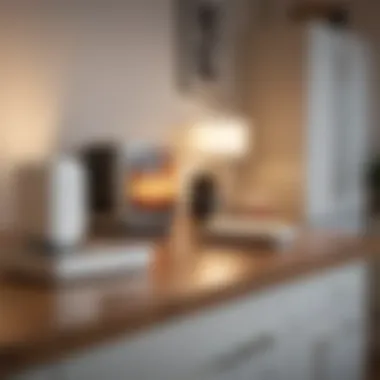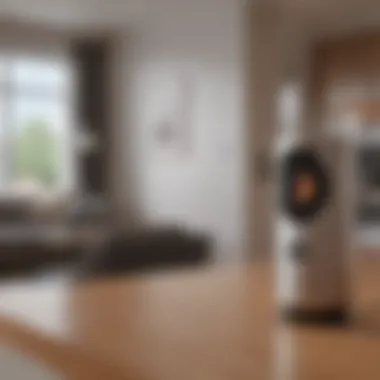Understanding HomeKit: Apple’s Smart Home Solution


Intro
In the digital age, our homes are getting smarter by the minute, a phenomena driven by the need for convenience, security, and energy efficiency. Apple's foray into this arena with HomeKit offers a unique blend of user-friendliness and robust integration. This guide aims to shine light on how HomeKit serves as a backbone for smart home devices, facilitating control via Apple devices. We will discuss not just the basics, but also touch on its key features, compatibility spectrum, security frameworks, and the overall lifestyle impact of adopting this technology.
Product Overview
HomeKit stands as Apple's dedicated platform for smart home automation, bridging the gap between various device ecosystems and Apple’s own hardware. With a suite of features designed to simplify user interaction, it serves both seasoned tech enthusiasts and new adopters alike. The essence of HomeKit is its seamless integration with Apple’s suite of products, allowing users to take control of their environment with just a few taps.
Overview of HomeKit
Launched in 2014, HomeKit provides an interface for controlling smart home products through iPhones, iPads, and even the Apple Watch. Users can create a diverse array of automations that can trigger lights, locks, cameras, and thermostats, enhancing the user experience and household efficiency. The innate compatibility with Siri means that voice commands can be seamlessly integrated into everyday routines, making tasks like adjusting the thermostat or turning off lights more intuitive.
Key Features and Specifications
One of the standout features of HomeKit is its focus on security. Utilizing end-to-end encryption, HomeKit ensures that a user’s data remains private. Other key aspects include:
- Scene Management: Users can group devices together and create personalized scenes, like "movie night" which dims the lights and lowers the shades with a single command.
- Remote Access: When paired with an Apple TV or HomePod, users can control their devices from anywhere with an internet connection.
- Automation Capabilities: Users can set schedules or create rules; for instance, turning on the porch light automatically at sunset.
HomeKit’s specifications also highlight its energy-saving capabilities, which can lead to lower utility bills and reduced environmental impact.
Comparison with Previous Models
While HomeKit’s core functionality has been consistent since its launch, Apple has rolled out additional features over time. The introduction of the Home app in iOS 10 allowed for a more streamlined experience compared to earlier iterations. Furthermore, support for Thread networking protocol enhances device interaction and efficiency, marking a significant leap from previous setups.
Performance and User Experience
Apple’s reputation for quality often translates into how HomeKit functions in practice.
Performance Analysis
In terms of performance, HomeKit handles device management swiftly. Users have indicated that the response time when executing commands is smooth and reliable, a critical aspect for real-time monitoring of smart devices. Moreover, the ability to set multiple devices working together does not diminish overall performance.
User Interface and Ease of Use
Navigating the Home app is generally intuitive, making it easy for anyone to adapt to its functionalities. Setting up new devices typically follows a straightforward path. Feedback from users often highlights the simplicity of adding devices to their smart home system, whether it’s lighting, security cameras, or temperature controls.
User Experience Feedback and Opinions
User reviews on platforms like Reddit suggest a strong overall satisfaction with HomeKit. Many appreciate how well it integrates with existing Apple technology, leading to a cohesive experience within the Apple ecosystem.
Security Features
One of HomeKit's significant advantages is its strong security framework. Unlike many other smart home systems, HomeKit enforces security measures that ensure users feel protected using the system. End-to-end encryption keeps data safe from unwanted access, which is crucial when considering the increasing prevalence of smart home hacks.
"HomeKit stands apart in its proactive approach to smart home security, making it appealing to privacy-conscious users."
Apple announced regular security updates, which ensures the HomeKit framework remains resilient against emerging threats.
Epilogue
Prelude to HomeKit
In an age where convenience and connectivity redefine how we interact with our living spaces, HomeKit represents a pivotal step forward in transforming homes into intelligent environments. Apple has carved a niche in the realm of smart home technology, making it essential for users to not only understand HomeKit but also its implications for modern living. This section lays the groundwork for grasping the relevance of this ecosystem, focusing on critical elements like usability, integration, and security.
Definition of HomeKit
HomeKit is Apple's comprehensive framework designed to enable seamless control of smart home devices through iPhones, iPads, and Apple TVs. At its core, HomeKit allows users to command appliances, lighting, and security systems—often from a single app. However, its capabilities extend well beyond simple on-off functionalities; it facilitates complex automation scenarios, enhancing comfort and efficiency.
To put it simply, with HomeKit, a homeowner can set up their lights to glow warmly at sunset or lock their door from across town without breaking a sweat. This holistic approach to smart home management is why many tech enthusiasts and Apple aficionados regard HomeKit as a game changer in domestic automation.
The Evolution of Smart Home Technology
The journey of smart home technology has been anything but linear. In the early days, it revolved chiefly around isolated devices that promised convenience but lacked the connectivity to work harmoniously. Devices like smart thermostats or automated lights existed in silos, with users often juggling multiple apps to control them.
Over time, the industry witnessed a significant shift. With platforms such as HomeKit emerging, the focus moved to creating an integrated ecosystem. Users began demanding interoperability, leading to groundbreaking developments that transcend traditional boundaries. Today’s devices communicate through various protocols, allowing for unprecedented levels of customization and user control.
The advent of AI and machine learning has propelled this evolution further, adding layers of intelligence that can learn user habits and preferences, thereby tailoring the experience accordingly. The evolution of smart homes represents not merely an enhancement in living standards but a reflection of our increasingly interconnected lives.
"The future belongs to those who believe in the beauty of their dreams." — Eleanor Roosevelt
Core Features of HomeKit


HomeKit stands as a significant player in the landscape of modern smart home technology. It introduces a cohesive ecosystem that merges convenience and functionality, but its true value lies in its core features, which cater to both novice users and tech aficionados. Understanding these features undermines the sheer versatility HomeKit offers for home automation and simplifies daily living.
Device Control and Automation
At the heart of HomeKit’s allure is its capability for device control and automation. This functionality is not just a fancy add-on; it represents a shift in how we interact with our living spaces. With the Home app, users can connect various compatible devices, from lights to locks and everything in between. The beauty lies in the automation features.
Imagine this: you wake up in the morning, and your smart blinds gently pull up at a designated time, letting in the sunshine while the coffee maker starts brewing your favorite blend. This is possible through automation routines, which can be set based on time, location, or even actions of other devices.
Moreover, this seamless control extends beyond basic commands. Users can set up scenes that involve multiple devices responding together. With a single tap, you can dim the lights, lock the doors, and adjust the thermostat, setting the perfect ambiance for movie night, all without lifting a finger.
User Interface and Accessibility
HomeKit’s user interface conveys simplicity and ease of access. The Home app is designed with user experience in mind, so whether you’re a tech savant or just getting your feet wet in smart home tech, navigating its features feels intuitive. Each device can be displayed with customizable icons, allowing users to personalize their control dashboard.
Additionally, accessibility is paramount. This framework accommodates various users, including those with disabilities. VoiceOver support enables visually impaired individuals to use HomeKit easily. The ability to hand off control to family members or trusted friends also ensures that everyone can enjoy the benefits of a smart home without needing to wrestle with convoluted setups.
Siri Integration
An aspect that makes HomeKit particularly compelling is its deep integration with Siri, Apple's virtual assistant. This voice-controlled feature allows users to commands their devices hands-free, adding a layer of convenience that complements the Home app.
Engaging Siri is effortless. A simple “Hey Siri, turn off the living room lights” executes the command right away. Beyond basic tasks, Siri can also handle more complex requests, such as creating scenes or checking the status of various devices, using natural language processing for a smooth interaction.
This integration not only simplifies everyday management but elevates the entire smart home experience, highlighting how HomeKit blends technology seamlessly into our lives. The option to control devices through voice prompts fosters an environment where managing your household feels less like a chore and more like second nature.
"With HomeKit, users appreciate a balance between control and ease that fits into their daily living seamlessly."
In summary, the core features of HomeKit establish it as a frontrunner in smart home technology. By enabling robust device control, ensuring user-friendly experience, and integrating voice assistance, it anticipates user needs while promoting a more intelligent and connected lifestyle.
Compatibility: Devices and Ecosystem
Understanding the compatibility of HomeKit with various devices and its ecosystem is crucial for a couple of reasons. First, it determines how effectively users can leverage HomeKit’s functionalities. Besides that, a well-integrated ecosystem fosters seamless automation across varied smart devices, enhancing the overall user experience. Let’s delve deeper into this topic—how do these elements function together in real-world situations?
Supported Devices and Brands
To fully enjoy what HomeKit has to offer, a user must be equipped with compatible devices. The beauty of HomeKit lies in its compatibility with an impressive range of products from various brands, which contributes significantly to the wide adoption of the framework.
Some notable brands that have embraced HomeKit include:
- Philips Hue: Offers smart lighting solutions, enabling users to control the ambiance of their home with a simple command.
- Ecobee: This brand's smart thermostats enhance energy efficiency by learning the user’s preferences over time.
- August: With smart locks, August allows users to manage home security effortlessly via their iPhones or iPads.
- Honeywell: Their security cameras and smart home sensors provide an additional layer of safety, integrating flawlessly with HomeKit.
Each of these brands contributes distinct advantages, whether it be ease of use, innovation in functionality, or energy savings. Furthermore, checking the HomeKit compatibility is simply a matter of scanning the packaging. Look for the “Works with Apple HomeKit” logo to avoid any nasty surprises.
HomeKit Accessories List
A myriad of accessories exists under the HomeKit umbrella, ranging from simple light bulbs to more advanced devices like smart home hubs. Some popular accessories include:
- Smart bulbs: Like those from LIFX, which allow users to dim lights and change colors with a verbal command.
- Smart plugs: These devices, such as those offered by Wemo, permit users to turn traditional appliances into smart ones simply by plugging them in.
- HomeKit-enabled cameras: Options from Logitech Circle can help you keep an eye on things, delivering live feeds and alerts when unusual activity is detected.
- Smart sensors: Products like Eve Room measure air quality, temperature, and humidity, feeding valuable data directly to the user’s iPhone.
The extensive accessory listing presents an excellent opportunity for customization, allowing users to mold their smart home to fit specific needs.
Interoperability with Other Protocols
Interoperability might sound like a technical term, but its importance can’t be overstated in the realm of smart homes. HomeKit operates smoothly with various communication protocols like Wi-Fi, Bluetooth, and Thread. This means devices can work together even if they come from different manufacturers.
For example, a user might have Philips Hue bulbs, a Nest thermostat, and a Wemo smart plug in their setup. With HomeKit, they can automate tasks such as:
- Adjusting the thermostat when there’s no one home, thereby saving energy.
- Turning off all lights when going to bed, ensuring safety and efficiency.
- Unlocking the door automatically when someone approaches with their iPhone.
The beauty of this interoperability lies in the seamless flow between devices, creating a unified experience that makes users feel like they’re living in the future. As smart homes continue to evolve, the ability to mix and match devices from various brands without a hitch will only become more critical.
“The interconnectedness of devices not only simplifies management but enhances the efficiency of daily routines.”
Overall, the compatible landscape of HomeKit devices and accessories, along with its interoperability, sets a solid foundation for a truly integrated smart home experience. As the technology progresses, ensuring that the devices can communicate efficiently, while being user-friendly, remains a paramount consideration for both manufacturers and users alike.
Security and Privacy Considerations
In today's digital age, where smart home devices are becoming a staple in many households, the importance of security and privacy cannot be overstated. This is especially true for HomeKit, which serves as Apple's central hub for managing various smart home devices. The interplay of innovation and privacy considerations often raises questions among users regarding how secure their data really is and the measures taken to protect their homes from unauthorized access.
Encryption and Data Protection
One pivotal element of security within HomeKit is encryption. Apple adopts strong encryption protocols, safeguarding data transferring between devices and the Apple ecosystem itself. Essentially, when a user communicates with their HomeKit devices, either through an iPhone, iPad, or Mac, the information relayed is encrypted. This means that even if someone managed to intercept the data traveling through the air, it would be nigh impossible to decipher without the appropriate keys.
- End-to-end encryption: This stretches across devices and utilizes secure channels to ensure no third party can eavesdrop on smart device communications.
- Local device management: HomeKit allows users to control devices locally without relying on cloud services, which further reduces exposure to potential external attacks.


"Apple believes your privacy is essential. Their stance is that information about users should never be combined with their personal profiles, keeping interactions secure and personal."
This layered approach ensures that the barriers to entry for malicious actors are significantly high, effectively maintaining a secure environment. The use of strong privacy policies also bolsters user confidence when utilizing HomeKit.
User Data Management
User data management is another cornerstone of HomeKit's security framework. Apple offers a transparent approach to how user data is collected, stored, and managed. Unlike some other smart home ecosystems, HomeKit does not store users’ data on its servers unless absolutely necessary. Typically, the data remains on the user’s devices, enhancing privacy control.
- User control: Users have the autonomy to manage how their data is shared across their devices, allowing them to customize permissions for each connected accessory, effectively limiting access.
- Regular updates: Apple periodically rolls out software updates that include security patches and enhancements, ensuring that vulnerabilities are mitigated in a timely manner.
In summary, HomeKit's dedication to privacy and security presents itself in various forms—strong encryption methods, local device management, and user-centric data policies. By fostering a secure environment, Apple not only enhances user trust but also sets a precedent for what a responsible smart home ecosystem should look like.
Advantages of Using HomeKit
Integrating smart home technology into daily life provides many benefits, and HomeKit stands out by offering a variety of features that simplify this experience for users. Whether you are an Apple aficionado or just curious about the potential of smart homes, understanding the reasons behind HomeKit's popularity is key. The advantages can be split into a few critical areas: ease of use, customization options, and the overarching benefits that come from being part of a cohesive ecosystem.
Ease of Use
One major selling point of HomeKit is how user-friendly it is. Apple designed the platform with its user base in mind, ensuring that even those who are not technologically savvy can navigate and operate it without much hassle. For instance, if you're using an iPhone, adding smart home devices is as simple as scanning a QR code or entering a code on your device, making the onboarding process feel effortless.
Once set up, controlling devices is straightforward. You can use the Home app on your iPhone, iPad, or Mac to access all connected devices at a glance. Want to dim your smart lights? A few taps, and you're good to go. If you have specific presets, like "movie night" or "wake-up routine," enabling those scenes is just as easy. This ease of operation is essential for those who desire convenience without a steep learning curve.
But the simplicity extends to voice commands as well. Siri integration allows you to command your devices hands-free. This is particularly handy when you find yourself juggling chores or running late in the morning. A quick, "Hey Siri, turn off the lights" removes any extra steps and keeps your daily routine running smoothly.
Customization and Automation Options
HomeKit also shines in its customization and automation capabilities. Users can create personalized experiences tailored to their needs. For example, you can set up automations based on your location — when you leave home, your thermostat can adjust to save energy, or when you return, lights could turn on automatically. This level of adaptability saves users time and can lead to significant energy savings.
Moreover, customization allows for combining devices from different brands to work in harmony, as long as they support HomeKit protocols. Thus, you can mix and match security cameras, sensors, and lighting from various manufacturers without worrying about compatibility issues. This flexibility is essential for tech enthusiasts who enjoy tweaking their systems.
In practical terms, this could mean programming your smart appliances to follow a set schedule. For example, you might want your coffee maker to start brewing precisely at 7:00 AM each weekday. Or perhaps you prefer to have the blinds raise automatically as the sun rises. Custom automations like these enhance your living experience and elevate the smart home concept beyond simple connectivity.
"Customization is the key to truly harnessing the full potential of HomeKit in your daily life. You can literally make your home work for you."
Limitations of HomeKit
Understanding the limitations of HomeKit is just as important as recognizing its capabilities. While Apple's framework is packed with features, it comes with constraints that can influence user experience and overall functionality. By acknowledging these limitations, users can make more informed decisions about their smart home setups.
Device Compatibility Challenges
One of the primary hurdles with HomeKit lies in its device compatibility. While it supports a variety of smart devices, not every product in the market plays nicely with Apple's ecosystem. For example, if you’ve got the latest gadget from a lesser-known brand, there’s a chance it won’t be HomeKit-enabled. This means users can end up with gadgets that are highly functional but remain outside the HomeKit umbrella.
"Not all devices that say they are smart are compatible with HomeKit, which can lead to a frustrating purchasing experience."
The issue of compatibility can extend to certain devices that might be available on the market but don’t meet the stringent criteria set by Apple. This creates a situation where users have to do their homework before committing to purchases, ensuring that any new device will easily integrate within their existing home setup.
- For instance, Philips Hue lights have fantastic HomeKit integration; however, some smart light brands may not even be on the radar.
- Moreover, Apple updates can further complicate matters. An update might inadvertently break compatibility for certain devices which were previously functioning without issues.
Ultimately, while HomeKit does offer a curated selection of devices, this can also lead to feelings of confinement among users seeking a more diverse array of smart home products.
Dependence on Apple Ecosystem
Another notable limitation is the heavy reliance on Apple's ecosystem. HomeKit performs optimally within environments populated by Apple devices. That is, if you want the best experience from your smart home setup, you’ll likely need an iPhone, iPad, or a Mac.
This dependence raises some concerns. If you happen to explore options outside of Apple’s realm, like Android devices or Windows platforms, you're essentially locked out. Your HomeKit-enabled devices won’t be as accessible without an Apple device around. This can be limiting, particularly for those who may switch platforms or who live with individuals using various tech ecosystems.
Moreover, this exclusivity also affects companion functionalities. Features such as remote access through iCloud Home can only be harnessed if you’re within Apple's fold, meaning you might miss out on interacting with your smart devices when away from your trusted Apple gadget.
- Additionally, maintaining an updated Apple device can cause an extra strain on budget-conscious consumers.
- New devices often come with a premium price tag, which may deter individuals interested in entering the smart home space.
In summary, while HomeKit creates an impressive connected experience, these limitations can affect both the purchasing decisions of consumers and the overall enjoyment of creating a fully-automated home.
Practical Applications of HomeKit
Exploring the practical applications of HomeKit offers a glimpse into how Apple's smart home technology fits into day-to-day living. Understanding how to leverage HomeKit can significantly enhance the homeowner's experience and create an atmosphere that is both convenient and efficient. Think of it as the secret sauce that makes the dishes of modern living a bit more palatable.
There are numerous ways HomeKit can mold a house into a smart home masterpiece, turning mundane tasks into automated routines. From controlling lights and security systems to managing home appliances, HomeKit delivers a cornucopia of features that reshape home life.
Home Automation Scenarios
Let's dive into some specific home automation scenarios that exemplify HomeKit's capabilities. Picture this: as your day unfolds, you can program your smart home devices to respond automatically to your movements and preferences.
- Morning Routine: You wake up, and with the dawn, your smart shades gently rise, the coffee machine starts brewing a fresh cup, and the thermostat adjusts to a cozy temperature. All this can occur without you lifting a finger, thanks to pre-set scenes in HomeKit.
- Away from Home: Imagine being able to set your home to 'Away Mode.' This feature can lock doors, turn off lights, and even simulate occupancy by scheduling lights to turn on and off at intervals. This not only boosts security but also provides peace of mind.
- Home Entertainment: Bringing friends over? With a simple voice command to Siri or a tap on your device, you can dim the lights, adjust the thermostat, and start the music, creating the perfect atmosphere for a gathering.


Utilizing HomeKit for these scenarios enhances convenience and boosts the overall functionality of your living space, making your home feel customized to your lifestyle.
Energy Management and Efficiency
Apart from convenience, energy management is another one of HomeKit's strong suits. Homeowners today are increasingly conscious about their energy consumption, and HomeKit provides tools that help in managing these resources more effectively. This not only saves money but also contributes to a sustainable future.
- Smart Thermostats: These devices can learn your schedule and adjust heating or cooling levels automatically. This means that when you’re not home, the thermostat can dial back on energy usage without you having to intervene manually.
- Lighting Control: You can program your lights to turn off when no one is in the room or to adjust based on the time of day. For instance, lights can be set to a warm setting during the evening to create a comforting ambiance while using less energy than daytime settings.
- Monitoring Usage: HomeKit allows you to track the energy usage of your devices. Knowing which appliances consume the most energy can help you make informed decisions about what to replace or when to use them, further enhancing your energy saving efforts.
Incorporating these energy management strategies via HomeKit can realize significant savings on utility bills while ensuring the family's comfort is not compromised.
"Smart homes are all about creating an environment that seamlessly blends comfort, security, and efficiency. With HomeKit, users can tap into a plethora of possibilities."
Overall, understanding and implementing these practical applications underscores HomeKit's role as a shining beacon in the smart home landscape, blurring the lines between technology and lifestyle.
User Experience and Feedback
User experience plays a crucial role in the adoption and popularity of HomeKit. It focuses on how users interact with the smart home framework and their overall satisfaction with it. Positive user experiences can lead to increased usage and brand loyalty, while negative experiences may dissuade potential users from exploring the technology further. Feedback can also provide valuable insights to developers, enabling them to enhance HomeKit's functionality and integration with devices. Thus, understanding user experience is not just a matter of collecting opinions; it’s also about shaping the future of smart home interactions.
Common User Perspectives
When it comes to HomeKit, users tend to express a variety of perspectives shaped by their individual needs and experiences. Some might emphasize the simplicity of controlling devices via the Home app, highlighting that it allows them to manage their smart home effortlessly, without feeling overwhelmed by a complex interface. Meanwhile, other users appreciate the automation capabilities that HomeKit offers, such as scheduling lights to turn on at sunset or having the thermostat adjust automatically when they leave home.
However, it’s not all sunshine and rainbows. An often discussed concern among Apple enthusiasts is the limited compatibility with non-Apple products. For example, while many praise the ingenious integration of devices like the Philips Hue bulbs, others lament the struggle when trying to incorporate more diverse products that aren’t fully compatible with HomeKit.
In essence, user perspectives on HomeKit frequently oscillate between high satisfaction regarding ease of use and automation features, and frustration related to compatibility issues.
Case Studies of Successful Implementations
Real-world examples of HomeKit implementation clearly illustrate its potential benefits and how it can truly enhance everyday life for various users.
One standout case is that of a family living in a suburban home. They embraced HomeKit by integrating a range of devices, including smart locks, lights, and a security camera. The primary goal was to ensure security and ease of access for family members, especially the children. With just their iPhones, they could lock or unlock doors remotely, providing both convenience and peace of mind. This installation not only streamlined their daily routine but also empowered them to manage their home more efficiently.
Another notable case comes from a tech-savvy individual who turned their small apartment into a smart living space. By using HomeKit-enabled plugs and light bulbs, they automated nearly every electrical device in the apartment. For instance, they scheduled the coffee machine to brew at 7 AM, and the lights to dim in the evening. This kind of smart home innovation not only created a cozy environment but also significantly reduced energy consumption, aligning with their goal of sustainability.
These examples underscore HomeKit’s versatility and its capacity to cater to diverse user needs—whether it's enhancing security, energy efficiency, or simply adding convenience to day-to-day tasks.
The Future of HomeKit and Smart Home Technology
As we steer towards a future replete with smart technologies, the role of HomeKit as a beacon of integrated home automation grows ever more significant. Apple has positioned HomeKit not only as a tool for individual users but as a vital component in the expanding universe of smart home tech. It stands to reason that understanding HomeKit's trajectory is imperative for anyone looking to make informed decisions about their smart home ecosystem. Through the lens of convenience, security, and energy efficiency, we can examine the nuances that define the path ahead for HomeKit in the broader landscape of smart living.
Predicted Trends in Smart Home Integration
The integration of smart home systems is expected to evolve tremendously in the coming years. One prevailing trend is the increasing interconnectivity between different smart devices from various manufacturers. No longer will users be bound to a single brand's ecosystem. Instead, HomeKit is likely to embrace greater compatibility with devices outside Apple’s immediate realm. Just look at how users have taken to demand seamless experiences—this could push Apple to partner with a broader array of smart tech companies, allowing them to enjoy more versatile setups while accommodating their preferences.
Moreover, with advancements in artificial intelligence, we can expect more intuitive automations emerge. Devices are likely to learn user habits more robustly, offering suggestions tailored to routines which can mean less manual interference for homeowners. For instance, imagine a smart speaker that recognizes when you usually come home from work and adjusts the thermostat or lights before you arrive. That’s the kind of convenience that’s on the horizon.
HomeKit's Role in Smart Cities
HomeKit doesn’t merely play a role in individual homes; its potential integration into smart cities is a fascinating concept that’s gaining traction. The push towards creating more sustainable and efficient urban environments means cities are now looking closely at IoT (Internet of Things) infrastructure. This is where HomeKit can fit in quite nicely.
For example, consider a scenario where HomeKit-enabled buildings communicate with city infrastructure. Streetlights that adjust based on pedestrian activity or traffic patterns that help ease congestion could be managed in a manner that’s efficient and eco-friendly—situations where every bit of automation contributes to improving urban life.
Additionally, housing developments could leverage HomeKit’s capabilities to enhance security features. Imagine apartments where residents can monitor their doors and surveillance through their Apple devices. As municipalities undertake smarter city initiatives, HomeKit may find its way as an integral player in making neighborhoods safer and more intelligent.
"The way forward in urban design will be defined by how seamlessly we integrate our home technologies with our city infrastructure."
In sum, the future of HomeKit is tightly woven with that of smart home technology generally. As user expectations rise and cities evolve, the emphasis on making homes, as well as urban landscapes, smarter becomes clearer. Whether you’re simply trying to dim the lights or orchestrating an entire smart city initiative, understanding where HomeKit fits into this expanding panorama will remain pivotal for enthusiasts and casual users alike.
Epilogue
The significance of concluding an exploration into HomeKit cannot be overstated. This home automation platform, developed by Apple, not only redefines how users interact with their living spaces but embodies the future direction of smart home technology. With crisp edges and a user-friendly approach, HomeKit stands as a paragon of integration between various smart devices and the Apple ecosystem.
Summary of HomeKit's Impact
HomeKit has had a profound effect on the smart home landscape. Its influence can be categorized into several key areas:
- Enhancing Accessibility: By allowing users to control a multitude of devices from a single interface—namely their iPhone, iPad, or Mac—HomeKit simplifies the traditionally complex realm of home automation. This unification streamlines the user experience and encourages widespread adoption among Apple fans and tech enthusiasts alike.
- Fostering Security: Safety measures such as end-to-end encryption ensure that user data remains protected, addressing one of the primary concerns among smart home users. The reassurance of privacy serves to enhance HomeKit’s appeal.
- Driving Innovation: With a commitment to interoperability, Apple has prompted many manufacturers to design accessories that are compatible with HomeKit. This trend not only fosters a more diverse ecosystem but also pushes the envelope of smart technology.
- Integration into Daily Life: The customized automation signifies HomeKit's crucial role in making everyday tasks more efficient. From setting specific lighting based on an activity to managing home climate seamlessly, the impact is palpable.
HomeKit’s fusion of functionality and design speaks to a broader acceptance of smart technologies, ensuring that they are not just gadgets, but rather supportive companions that enhance our lifestyles.
Final Thoughts on Smart Home Technology
Smart home technology is not merely a trend; it signifies a fundamental shift in how we perceive and interact with our environments. As we plunge deeper into the digital age, the integration of such technologies will become increasingly essential.
HomeKit stands at the intersection of innovation and user-centric design, setting a high bar for competitors. While it presents certain limitations, primarily its dependence on the Apple ecosystem, the benefits it provides often outweigh the drawbacks. HomeKit’s influence has opened discussions about privacy issues, data management, and sustainable living practices.
Adopting smart home technologies like HomeKit indicates a willingness to embrace change and progress. It's not just about convenience—it's about creating an efficient, responsive, and, importantly, a safer living environment for everyone involved. The future holds great promise, with smart technology continuing to evolve and integrate more seamlessly into our daily lives.
"In the future, homes won’t just be buildings; they will be environments responding to our needs before we even articulate them."



